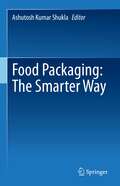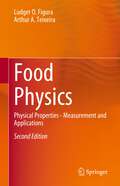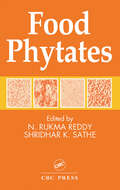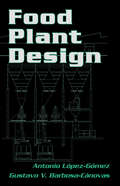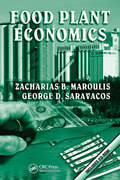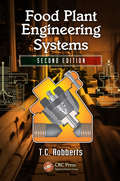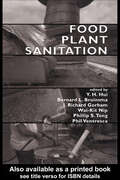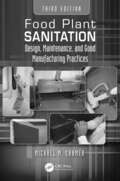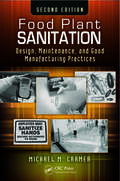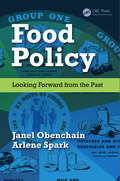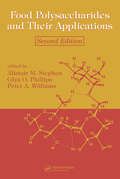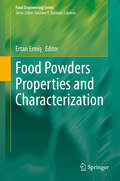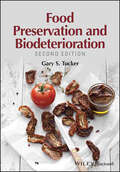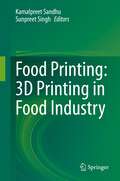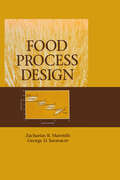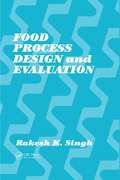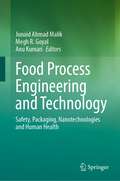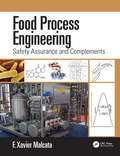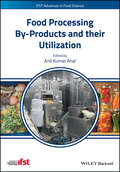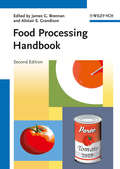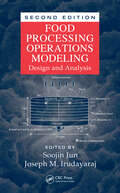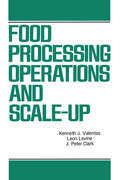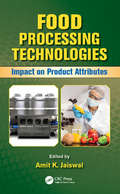- Table View
- List View
Food Packaging: The Smarter Way
by Ashutosh Kumar ShuklaThis book reviews the science and technology of food packaging and covers the potential innovations in the food packaging sector. At the same time, it highlights the issues and prospects for linking the laboratory research to the market. In addition to typical packaging requirements such as food quality, shelf life, protection, communication, and marketing, the book emphasizes the need for novel packaging materials, including biodegradable packaging for a variety of food products. A wide range of food products has been kept in focus and includes animal-based food products such as dairy products and sea foods. The book presents the next level of packaging solutions i.e., smart packaging with the applications of potential tools such as intelligent and active packaging, and includes the latest research on emerging digital technologies for packaging development, assessment, and acceptability. It further highlights the strategies including blends, reinforcing agents, cold plasma, UV light applications, chemical, and enzymatic methods and explores the new opportunities leading to improvement in the packaging performance. Smart freshness indicator applications, including gas and time-temperature indicators for quality and safety of packaged products, have been covered in detail. The book also includes the functional characteristics of edible films and coatings, including their bioactive characteristics. Finally the book presents the rules and regulation related to packaging.
Food Physics: Physical Properties - Measurement and Applications
by Arthur A. Teixeira Ludger O. FiguraThis is the first textbook in this field of increasing importance for the food and cosmetics industries. It is indispensable for future students of food technology and food chemistry as well as for engineers, technologists and technicians in the food industries. It describes the principles of food physics starting with the very basics – and focuses on the needs of practitioners without omitting important basic principles. It will be indispensable for future students of food technology and food chemistry as well as for engineers, technologists and technicians in the food industries. Food Physics deals with the physical properties of food, food ingredients and their measurement.
Food Phytates
by N. Rukma Reddy Shridhar K. SatheFood Phytates takes a new look at phytates, including their potential health benefits. It includes the latest information on the beneficial heath effects of phytates, the influence of phytates in disease prevention, the potential use of phytate as an antioxidant in foods, and phytase expression in transgenic plants. In 14 chapters, leading research
Food Plant Design (Food Science and Technology)
by Gustavo V. Barbosa-Canovas Antonio Lopez-GomezAlthough chemical engineering and food technology are subject areas closely related to food processing systems and food plant design, coverage of the design of food plants is often sporadic and inadequately addressed in food technology and engineering books. Some books have attempted to treat food engineering from this dual point of view but, most
Food Plant Economics (Food Science and Technology)
by George D. Saravacos Zacharias B. MaroulisApplying the proven success of modern process engineering economics to the food industry, Food Plant Economics considers the design and economic analysis of food preservation, food manufacturing, and food ingredients plants with regard to a number of representative food processes. Economic analysis of food plants requires the evaluation of quantitative data from the design and operation of food processes and processing plants. Accompanying downloadable resources include prepared Excel spreadsheets for calculating various food plants scenarios by applying appropriate data regarding the cost of equipment and equipment sizing, material and energy balances, and plant operating costs. Beginning with a thorough background in the economics of a food plant, the first three chapters summarize recent advances in food process and research technology, the structure of the food system in the US and EU, and the principles of modern design in food processes, processing equipment, and processing plants. The second three chapters discuss process economics in relation to the food industry by applying the concepts of capital cost, operating cost, and cash flow to estimations of plant profitability. Detailed chapters cover estimations of capital investment and operating costs including statistical data, empirical models, and useful rules of thumb. The remaining three chapters apply the techniques of the previous discussions to food preservation plants such as concentration, canning, and dehydration; manufacturing plants including wine, bread, and yogurt; as well as ingredients plants that produce sugars and oils. A useful appendix contains a glossary, tables, conversions, nomenclature, food properties, and heat transfer coefficients.A practical and comprehensive treatment of process economics, Food Plant Economics provides a complete introduction to the application of this efficient technique to the food industry.
Food Plant Engineering Systems
by Theunis Christoffel RobbertsThe component parts of a manufacturing system are important. Without peripherals and services such as pumps, boilers, power transmission, water treatment, waste disposal, and efficient lighting, the system will collapse. Food Plant Engineering Systems, Second Edition fills the need for a reference dealing with the bits and pieces that keep systems
Food Plant Sanitation (Food Science and Technology)
by Y. H. Hui Wai-Kit Nip Bernard L. Bruinsma J. Richard Gorham Phillip S. Tong Phil VentrescaComprehensive and accessible, Food Plant Sanitation presents fundamental principles and applications that are essential for food production safety. It provides basic, practical information on the daily operations in a food processing plant and reviews some of the industry's most recent developments. The book is unique from others on the topic in th
Food Plant Sanitation: Design, Maintenance, and Good Manufacturing Practices
by Michael M. CramerFood safety and quality are primary concerns in the food manufacturing industry. Written by an author with more than 40 years’ experience in the food industry, Food Plant Sanitation: Design, Maintenance, and Good Manufacturing Practices, Third Edition provides completely updated practical advice on all aspects of food plant sanitation and sanitation-related food safety issues. It offers readers the tools to establish a food safety system to help control microbiological, physical, and chemical hazards. Understanding that sanitation is integral to food safety is the foundation for an effective food safety system. Features of this new edition include new photographs, tables, and up-to-date material that better reflect current guidance on food plant sanitation, including additional information on the implementation of FSMA. The chapters address testing for and control of microorganisms in food manufacturing, including recent challenges in the industry due to pathogens such as Listeria monocytogenes. They also offer discussions on biofilms, regulatory requirements from the European Union, allergens, sanitary facility design, and describe proven best practices for sanitation as well as current sanitary requirements and regulatory changes from the FDA and USDA. In addition, the author presents methods for verifying sanitation, and provides greater differentiation of verification versus validation. The final chapters identify good manufacturing practices for employees and present a comprehensive pest management plan, including control measures and chemical interventions. The book concludes with strategies for preventing chemical and physical food safety hazards. This reference provides a practical perspective for implementing food plant sanitation and safety processes. The author has included, wherever possible, examples of procedures, forms, and documents to help novice food safety and quality professionals develop effective food safety systems.
Food Plant Sanitation: Design, Maintenance, and Good Manufacturing Practices, Second Edition
by Michael M. CramerFood safety and quality are primary concerns in the food manufacturing industry. Written by an author with more than 35 years' experience in the food industry, Food Plant Sanitation: Design, Maintenance, and Good Manufacturing Practices, Second Edition provides completely updated practical advice on all aspects of food plant sanitation and sanitati
Food Policy: Looking Forward from the Past
by Arlene Spark Janel ObenchainAccess to safe, adequate, and nutritionally balanced food is a cornerstone of public health. Food Policy: Looking Forward from the Past examines the influences of grassroots movements, the government, and industry on the US food systems. The authors explore the intersection of food and nutrition and how policy influences this overlap. They illumina
Food Polysaccharides and Their Applications
by Peter A. Williams Glyn O. Phillips Alistair M. StephenComprehensive in scope, Food Polysaccharides and Their Applications, Second Edition explains the production aspects and the chemical and physical properties of the main classes of polysaccharaides consumed as food, highlighting their nutritional value and their technological characteristics.Chapters in this new edition detail the source,
Food Powders Properties and Characterization (Food Engineering Series)
by Ertan ErmişFood powders are an increasingly important aspect of processed food worldwide. Essential factors such as ease of storage and transport and usage convenience have greatly benefited the food industry and promise further advancements in processing techniques. Food powders can be stored for a longer period of time than other food products, making them essential for food supply in many regions of the world. There have been numerous research works on food powders properties and characterization, but there has not been an updated comprehensive review in this field. Food Powders Properties and Characterization is designed as an essential reference for individuals in the food industry and academia seeking a singular source that covers most of the basic aspects of food powders. With chapters focusing on the general properties of food powders, characterization of particle and bulk properties, adhesion and surface properties, this text presents comprehensive and fully up to date coverage of this challenging and important field.
Food Preparation (3rd edition)
by R. T. Miller Robert G. HainesUpdated with 2005 USDA dietary guidelines and the new food pyramid, along with new materials on sanitation, computerized food service management systems, first aid and fire safety procedures, diet trends, and temperatures for cooking, cooling, and hot and cold storage, this comprehensive text emphasizes cost-effective and safe techniques along with advice on professional development. In 30 chapters Haines and Miller cover such topics as careers in food service, sanitation, tools and equipment, safety, nutrition, cooking methods and techniques, breakfast preparation, batter cooking, appetizers, seasonings, salads, cheeses, fruit, vegetables, pasta, soups, meat and fish, breads, cookies, pastries and specialty desserts. The also include hundreds of large-scale recipes (finally we know how to make six Key Lime pies at once), a glossary, and appendices on such topics as the mathematics related to food preparation. They have included a number photographs so well-done readers may be tempted to eat the pages.
Food Preservation and Biodeterioration
by Gary S. TuckerBiodeterioration is the breakdown of food by agents of microbiological origin, either directly or indirectly from products of their metabolism. Preservation on the other hand is the process by which food materials are maintained in their original condition or as close to this as possible. This second edition of Food Preservation and Biodeterioration is fully updated and reorganised throughout. It discusses how the agents of food biodeterioration operate and how the commercial methods available to counteract these agents are applied to produce safe and wholesome foods. With this book, readers will discover traditional methods as well as major advances in preservation technology. Both microbiological and chemical pathways are analysed. This topic being important to all producers of food, the readership spans food scientists across industry and academia, particularly those involved with safety and quality.
Food Printing: 3D Printing in Food Industry
by Sunpreet Singh Kamalpreet SandhuThis book provides a comprehensive overview of the technical notes, research designs, literature, and 3DP (three-dimensional printing) technology applications for effective food printing. It provides a multidisciplinary coverage of 3D food printing in different food sectors. Recent advancements in manufacturing processes have led food industries to create innovations to stay competitive in the market. 3D food printing incorporates 3DP digital gastronomy strategies to manufacture food products with consistency in shape, color, flavor, texture, and even nutrition. Thus, by controlling the number of materials and the quality of nutrients, food items can be manufactured and handled to fulfill their particular requirements. For food printing, both proprietary structures and self-developed frameworks are used from open sources. Similar frameworks are re-engineered to reformulate administration, content creation, and user interface. For example, three printing medium types, natural printable products, non-printable synthetic food products, and alternative ingredients as well as two recipe forms (i.e., element-based recipes and regular recipes) are used for customized food production. The authors address that open 3D technology for food printing and food processing technology are theoretically correlated with food printing. The book will help industrial designers, nutrition professionals, dieticians, manufacturing enterprises, and young researchers in food technology, material science, and mechanical engineering understand the latest advances in 3DP technology in food industries.
Food Process Design
by Zacharias B. Maroulis George D. SaravacosThis timely reference utilizes simplified computer strategies to analyze, develop, and optimize industrial food processes and offers procedures to assess various operating conditions, engineering and economic relationships, and the physical and transport properties of foods for the design of the most efficient food manufacturing technologies and eq
Food Process Design and Evaluation
by Rakesh Kumar SinghThis book provides detailed illustrated reports on important recent advances in processing of foods including separation, mixing, preservation, and extrusion. The authors are specialists in food processing from North America and Europe. The reports were originally presented at the Conference of Food Engineering sponsored by the American Institute of Chemical Engineers in 1992 and 1993; they were selected, rewritten and updated for this book.
Food Process Engineering Operations (Contemporary Food Engineering)
by George D. Saravacos Zacharias B. MaroulisA unique and interdisciplinary field, food processing must meet basic process engineering considerations such as material and energy balances, as well as the more specialized requirements of food acceptance, human nutrition, and food safety. Food engineering, therefore, is a field of major concern to university departments of food science, and chem
Food Process Engineering and Technology: Safety, Packaging, Nanotechnologies and Human Health
by Megh R. Goyal Junaid Ahmad Malik Anu KumariThis book focuses on novel technologies related to food processing technology and engineering. It also focuses on food safety, quality and management, the scope of the Internet of Things (IoT) in food processing and its management, bioengineering tools for crop improvement in agriculture, recent innovations in food packaging, nanotechnology in food processing, and the nutritional health benefits of food. 3D printed food, an interesting and increasingly popular concept among the public today, is a meal prepared through an automated additive process using 3D food printers. This book is a ready reference for food researchers, students, and industry professionals. The book updates the current scenario of food processing technology and engineering for readers from agriculture and its allied fields including students and researchers of food science and technology, dairy science and technology, packaging industry, people working in food safety organisations, and researchers in the field of nanotechnology.
Food Process Engineering: Safety Assurance and Complements
by F. Xavier MalcataFood Process Engineering: Safety Assurance and Complements pursues a logical sequence of coverage of industrial processing of food and raw material where safety and complementary issues are germane. Measures to guarantee food safety are addressed at start, and the most relevant intrinsic and extrinsic factors are reviewed, followed by description of unit operations that control microbial activity via the supply of heat supply or the removal of heat. Operations prior and posterior are presented, as is the case of handling, cleaning, disinfection and rinsing, and effluent treatment and packaging, complemented by a brief introduction to industrial utilities normally present in a food plant. Key Features: Overviews the technological issues encompassing properties of food products Provides comprehensive mathematical simulation of food processes Analyzes the engineering of foods at large, and safety and complementary operations in particular, with systematic derivation of all relevant formulae Discusses equipment features required by the underlying processes
Food Processing By-Products and their Utilization (IFST Advances in Food Science)
by Anil Kumar AnalFood Processing By-Products and their Utilization An in-depth look at the economic and environmental benefits that food companies can achieve—and the challenges and opportunities they may face—by utilizing food processing by-products Food Processing By-Products and their Utilization is the first book dedicated to food processing by-products and their utilization in a broad spectrum. It provides a comprehensive overview on food processing by-products and their utilization as source of novel functional ingredients. It discusses food groups, including cereals, pulses, fruits, vegetables, meat, dairy, marine, sugarcane, winery, and plantation by-products; addresses processing challenges relevant to food by-products; and delivers insight into the current state of art and emerging technologies to extract valuable phytochemicals from food processing by-products. Food Processing By-Products and their Utilization offers in-depth chapter coverage of fruit processing by-products; the application of food by-products in medical and pharmaceutical industries; prebiotics and dietary fibers from food processing by-products; bioactive compounds and their health effects from honey processing industries; advances in milk fractionation for value addition; seafood by-products in applications of biomedicine and cosmeticuals; food industry by-products as nutrient replacements in aquaculture diets and agricultural crops; regulatory and legislative issues for food waste utilization; and much more. The first reference text to bring together essential information on the processing technology and incorporation of by-products into various food applications Concentrates on the challenges and opportunities for utilizing by-products, including many novel and potential uses for the by-products and waste materials generated by food processing Focuses on the nutritional composition and biochemistry of by-products, which are key to establishing their functional health benefits as foods Part of the "IFST Advances in Food Science" series, co-published with the Institute of Food Science and Technology (UK) This bookserves as a comprehensive reference for students, educators, researchers, food processors, and industry personnel looking for up-to-date insight into the field. Additionally, the covered range of techniques for by-product utilization will provide engineers and scientists working in the food industry with a valuable resource for their work.
Food Processing Handbook (Second Edition)
by Alistair S. Grandison James G. BrennanThe second edition of the Food Processing Handbook presents a comprehensive review of technologies, procedures and innovations in food processing, stressing topics vital to the food industry today and pinpointing the trends in future research and development. Focusing on the technology involved, this handbook describes the principles and the equipment used as well as the changes - physical, chemical, microbiological and organoleptic - that occur during food preservation. In so doing, the text covers in detail such techniques as post-harvest handling, thermal processing, evaporation and dehydration, freezing, irradiation, high-pressure processing, emerging technologies and packaging. Separation and conversion operations widely used in the food industry are also covered as are the processes of baking, extrusion and frying. In addition, it addresses current concerns about the safety of processed foods (including HACCP systems, traceability and hygienic design of plant) and control of food processes, as well as the impact of processing on the environment, water and waste treatment, lean manufacturing and the roles of nanotechnology and fermentation in food processing. This two-volume set is a must-have for scientists and engineers involved in food manufacture, research and development in both industry and academia, as well as students of food-related topics at undergraduate and postgraduate levels. From Reviews on the First Edition: "This work should become a standard text for students of food technology, and is worthy of a place on the bookshelf of anybody involved in the production of foods." Journal of Dairy Technology, August 2008 "This work will serve well as an excellent course resource or reference as it has well-written explanations for those new to the field and detailed equations for those needing greater depth." CHOICE, September 2006
Food Processing Operations Modeling: Design and Analysis, Second Edition (500 Tips)
by Soojin Jun Joseph M. IrudayarajThe second edition of Food Processing Operations Modeling focuses on novel processing technologies relevant to food safety and quality as well as new commercialized computational fluid dynamics software to model complex food processing systems. Addressing engineering principles and backed by numerical approaches, this edition features new chapters that provide in-depth coverage of high-pressure processing design and analysis, pulsed electric field processing and modeling, radio frequency heating, ozone treatment, and UV pasteurization of food materials. The text updates new information on infrared heating of biological materials as well as modeling electrical resistance heating of foods.
Food Processing Operations and Scale-up
by J. Peter Clark Kenneth J. Valentas Leon LevinIntended for students and practitioners who have a basic education in chemical engineering or food science. Contains basic information in each area and describes some of the fundamental ideas of processing development and design. Examines the food industry structure, how it works, consumer products,
Food Processing Technologies: Impact on Product Attributes
by Amit K. JaiswalThe processing of food generally implies the transformation of the perishable raw food to value-added products. It imparts benefits, such as the destruction of surface microflora, and inactivation of deleterious enzymes, such as peroxidase, leading to a greater shelf life of the food. It also enhances color and texture while maintaining quality of products and makes them edible. However, it also has an inevitable impact on nutritional quality attributes, such as increase or decrease in certain vitamins and bioactive metabolites among others. Food Processing Technologies: Impact on Product Attributes covers a range of food processing technologies and their effect on various food product attributes, such as bioactive compounds, safety, and sensory and nutritional aspects of the food upon processing. There are eight major parts in the book. Part I covers the conventional processing technologies. Parts II, III, IV, and V deal with various novel processing technologies, including impingement processing technologies, electro-magnetic processing technologies, physico-mechanical processing technologies, and electro-technologies. Part VI introduces chemical processing technologies. Part VII comprise irradiation processing technology, and the final part is focused on biological processing technology, detailing the application of enzymes in food processing. Numerous studies were carried out to find the impact of these processing technologies on various aspects of food and associated health promotion properties. Both positive and negative results were obtained based on nature of foods, processing type, and duration of processing, and this book covers these results in depth.
